Hacking The Hiring Process: Recruiters & Headhunters
They're a popular target for ridicule and public bashing on LinkedIn, but recruiters and headhunters can be an invaluable asset if you're willing to pull your head out of your own ass and think strategically.
Sure, you might be good at selling yourself, but likely not as good as someone who sells the idea of you as a prospective employee for a living.
Learn how to attract the attention of, reach out to and build a long-lasting relationship with recruiters and headhunters. I promise you it'll pay off!
Hacking The Hiring Process is a series of deep dives into each stage of the technical hiring process, with real, actionable advice and examples you can take away and implement immediately in your next job search.

BLUF - Bottom Line Up Front
If you just want a specific piece of advice in this article, the below list details the areas we'll be going through in this article:
- What is the role of a recruiter or headhunter?
- How to attract the attention of a recruiter or headhunter?
- How to build a fruitful, long-term relationship with a recruiter or headhunter
- The value of having a recruiter in your corner when the market turns!
- Examples of outreach scripts you can use to reach out today!
What is the role of a recruiter or headhunter?
Before answering this one, let's go up one level and answer the following question:
Why use a recruiter or headhunter at all? Isn't that what job boards are for?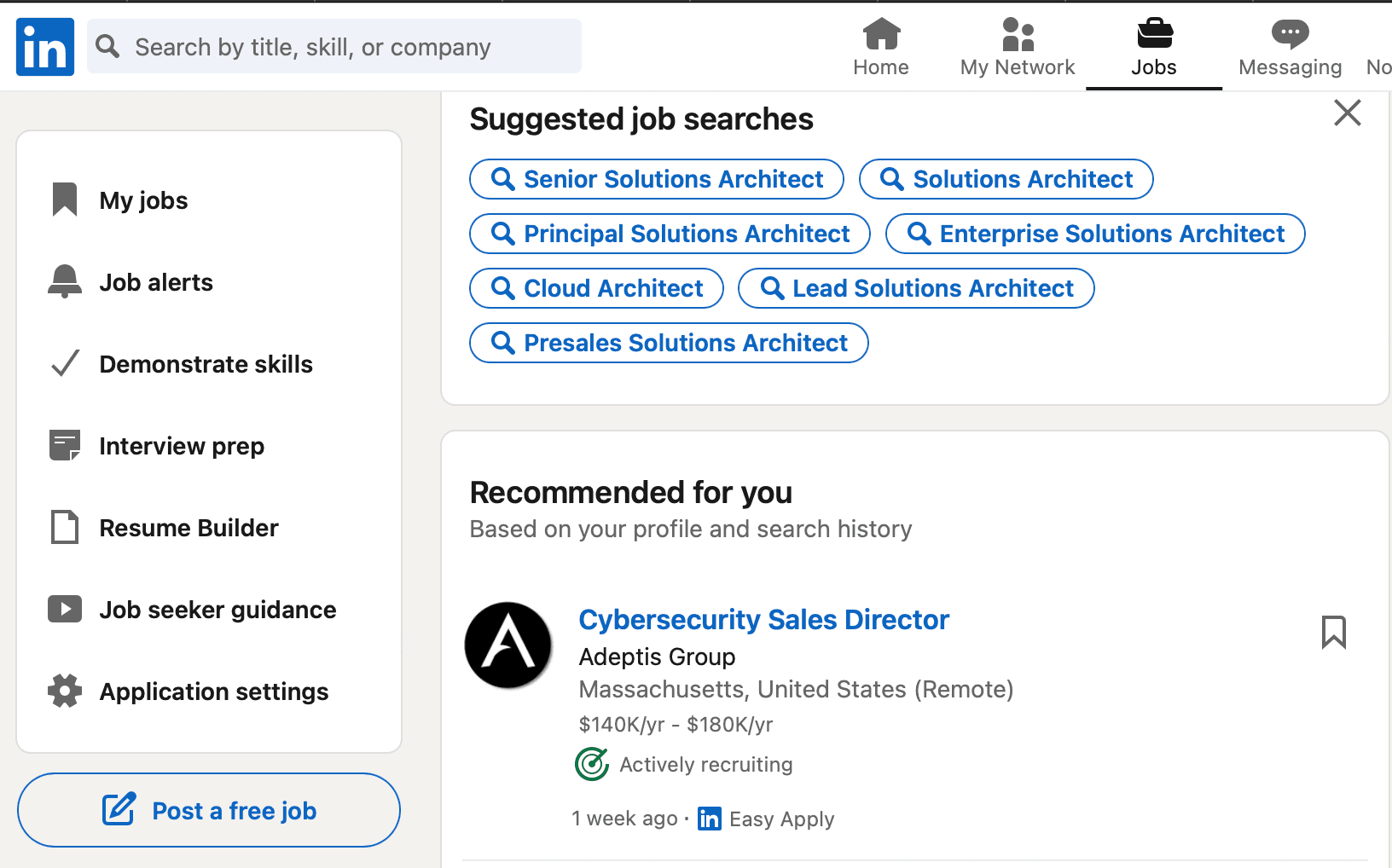
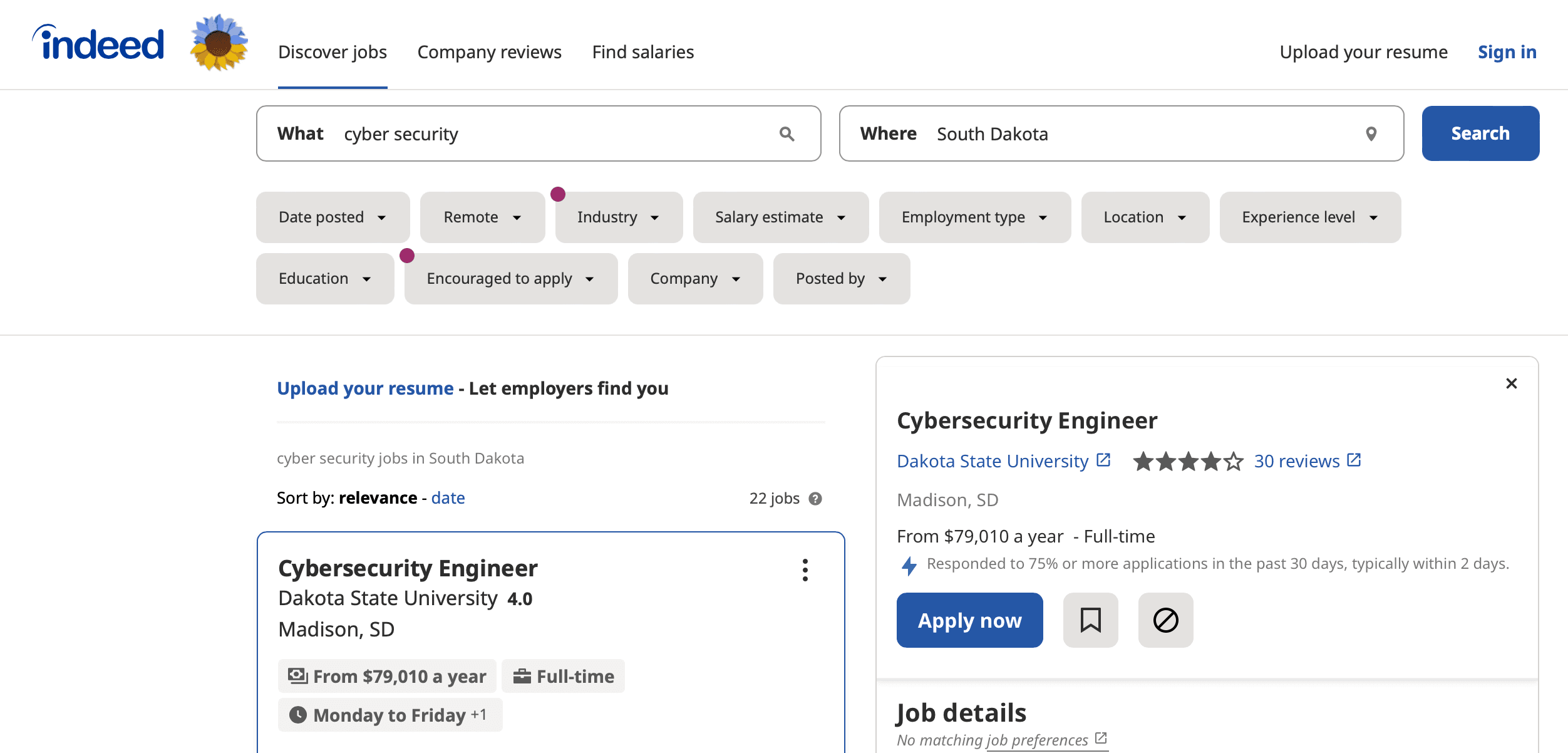
Ask most people where they'd start looking when it comes to looking for jobs in the tech industry and they'll probably point to one of the two above sites: LinkedIn and Indeed.
There's also a million sites out there that do the exact same things - your ZipRecruiters, your Dice, to offer a few examples.
-
An employer will create a job description for a given role, decide on what information they want to share to the world and then decide on which public platform (or range of platforms) they want to share that job description on.
-
The jobs board aggregates all of the individual job descriptions submitted by employers and displays them using the site's user interface.
-
An employee or jobseeker will use that interface to browse those descriptions and apply for any roles that they feel interested and/or qualified enough to throw their hat into the ring for.
Jobs boards aren't complicated, so why would you want to look at talking with recruiters or headhunters?
You want to talk to these individuals because of their access to the hidden job market.
The "Hidden" Job Market?
You might have heard the stat that "80% of job vacancies are never advertised", instead being sourced and filled through networking and direct referrals - thus never hitting the jobs boards in the first place.
Whilst this has been confirmed to be a myth, what people mean when they refer to a "hidden" market for jobs are all the opportunities that are simply sourced and hired through a different route than the commonly used jobs board.
Let's break it down:

On the left, we have the standard way most jobs (in most industries) are advertised and hired through. We just went through how it works in the last section:
- Employers write job descriptions and list them on the board,
- Jobs board stores and displays these job descriptions and hosts the jobseeker/employee accounts and allows them to apply,
- Jobseekers search the job descriptions and apply to those they find attractive.
As a jobseeker, when you apply for these jobs through jobs boards, you are in competition with literally every other person on that board that also applied.
Your application will fall into the same pool of resumes and cover letters as everyone else and you have no advantage over anyone else other than how much work you've put into that resume and how impressive your experience is overall.
On the right, we introduce two companies that don't want to deal with the enormous time and opportunity cost of wading through dozens or even hundreds of applications.
What they've done instead is take that same description and take it to a trusted recruitment partner (these can be freelancers or whole agencies) or headhunters and told them what an "ideal candidate" looks like.
- They'll dictate things that are must-haves, nice-to-haves and what the overall compensation range is for the job being hired for - amongst other things that candidates commonly want to know before applying.
- Armed with that information, the recruiter or headhunter will then use their own network of industry professionals and contacts and identify a list of "targets" to approach.
- The recruiter initiates contact with a target and discusses the job with them. If the recruiter or headhunter is good at their job, the target agrees to apply for the job.
- Commonly that recruiter will track the progress of the application, update the candidate and coach them as best they can through the process.
- If the candidate is successful, after a certain period of time that the now-employee has worked with the employer - a percentage of the candidate's salary will be paid as commission to the recruiter or headhunter.
- Commission will range wildly depending on the agency, seniority of recruiter and difficulty of hire.
Candidates only using jobs boards and not engaging with recruiters are missing out on the entire population of jobs that are instead hired through this alternative channel and are at a distinct disadvantage as a result.
This job market isn't hidden and it never really was.
The door just looks a little different, is all! That door is recruiter and/or headhunter-shaped, and that's the role that they play in the job-searching process.
Attracting the Attention of a Recruiter or Headhunter
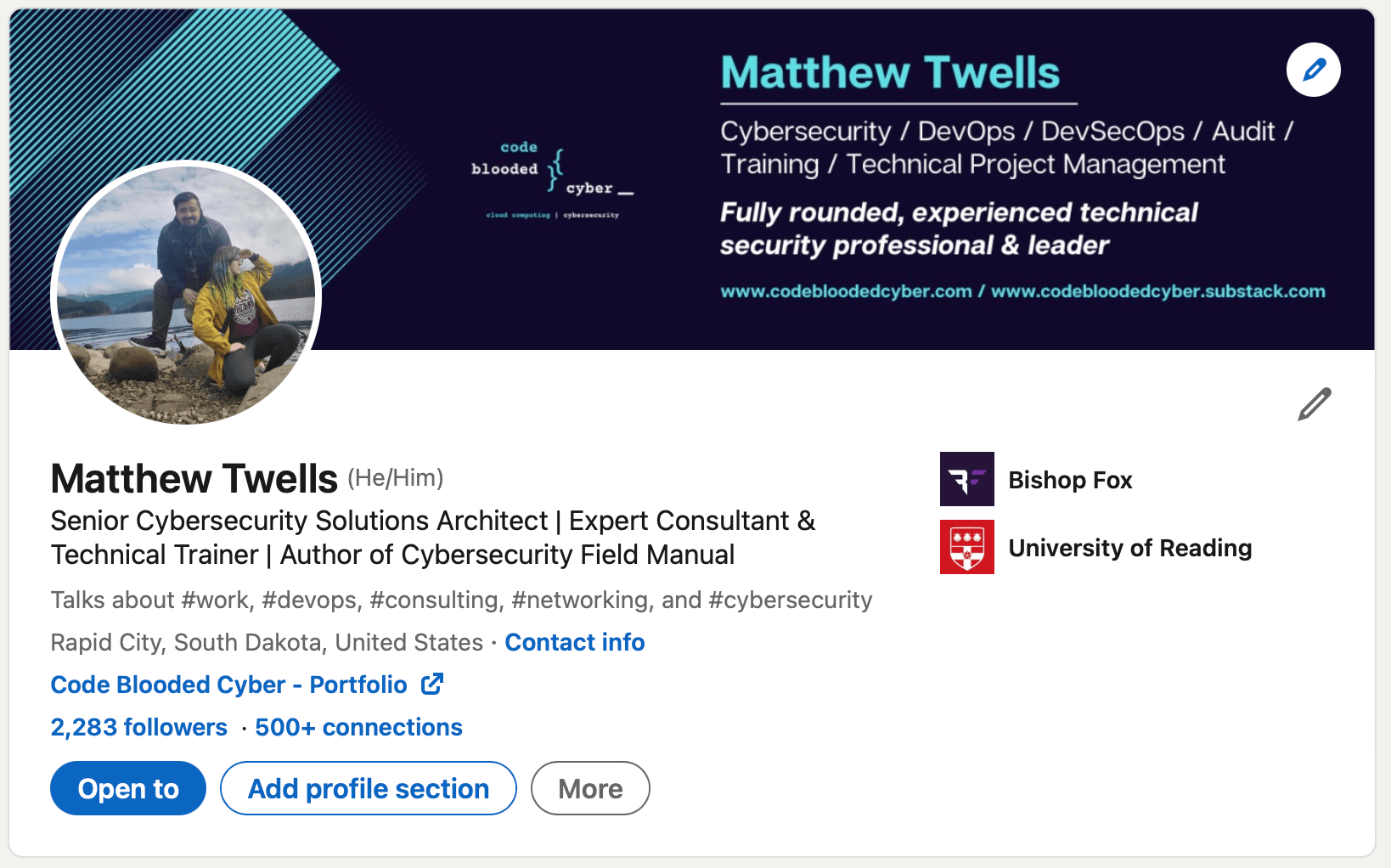
With the job market as it is right now in 2023, you can't afford for your public profile on sites like LinkedIn to not be on point.
The pool of candidates is deep and some exceptional talent has been laid off in almost every section of the tech industry, so you need to make sure that you're putting your best foot forward with every opportunity you have.
Even if you're not looking, it's worth taking a good look at your resume and LinkedIn profiles in some detail and asking yourself whether you could truly rely on them if you needed to.
We've looked at reworking your LinkedIn profile and broken down how to put a sharp resume together in other CodeBlooded Cyber articles, but we're gonna run through some specific changes you can make right now to help sharpen things to a fine point.
The BannerRecruiters and headhunters utilize a different form of LinkedIn called LinkedIn Recruiter, and are fundamentally using the website in a very different way than you or I might.
These people look at people's profiles all day, every day and are primarily looking for the answer to three main questions:
- Who are you?
- What is it that you do?
- Are you any good at it and where can I see more?
Do it right and you can answer all three of these in one fell swoop using a well-designed LinkedIn Banner.

As you can see above, you can use a site like Canva to put a good one together. Canva has a free to use tier or it's $12 per month or so for the Professional tier, and it has over 6,000 professionally designed LinkedIn Banner templates for you to choose from.
I really wouldn't overthink this on the design front - pick something simple, easy to read and not too garish (try not to go for anything neon, it doesn't look good on screens). Choose whatever personally brings you joy!
- As it's the first thing that a LinkedIn profile visitor will see, make sure there's some sort of visual intrigue involved. This can be a geometric shape, design or pattern that catches the eye.
- The overall color scheme honestly isn't all that important, but a brighter accent colour works well on a gray, white or dark blue background.
- Make sure that when you're done, the three questions above are all answered to some degree.

Looking at my profile in the example above, I have:
- My name in clear, bolded text at the top (question 1 answered),
- A list of areas of expertise that I am happy to be quizzed on underneath (question 2 answered),
- A short statement describing who I am and the URL to my website (question 3 answered)
Design-wise with mine, I went for my name in light blue to stand out against a navy blue background, with a simple line-based crosshatching pattern in the same colour.
As long as it's eye-catching and has the required info, feel free to get a little creative.
The Headline SectionYour Headline section is what comes underneath your profile picture and name on your LinkedIn profile. To a busy recruiter, this might be the last thing they read on your profile before moving on if it doesn't catch their attention.
With this in mind, let's look at how we can quickly put together a good headline section together.
You might have heard the term "elevator pitch" before, referring to a one or two sentence summary of a concept or business that can effectively generate interest in the short time it takes to ride an elevator with someone of influence.
This is more or less what this section is for - it's an elevator pitch for you as a professional.
This section needs to quickly summarize who "you" are as a professional and why anybody should go any further in learning about what you're all about.
Understandably, a lot of people find this incredibly difficult and either go too general or don't use this field effectively at all. So let's use our new friend GPT-4 and see what it comes up with:
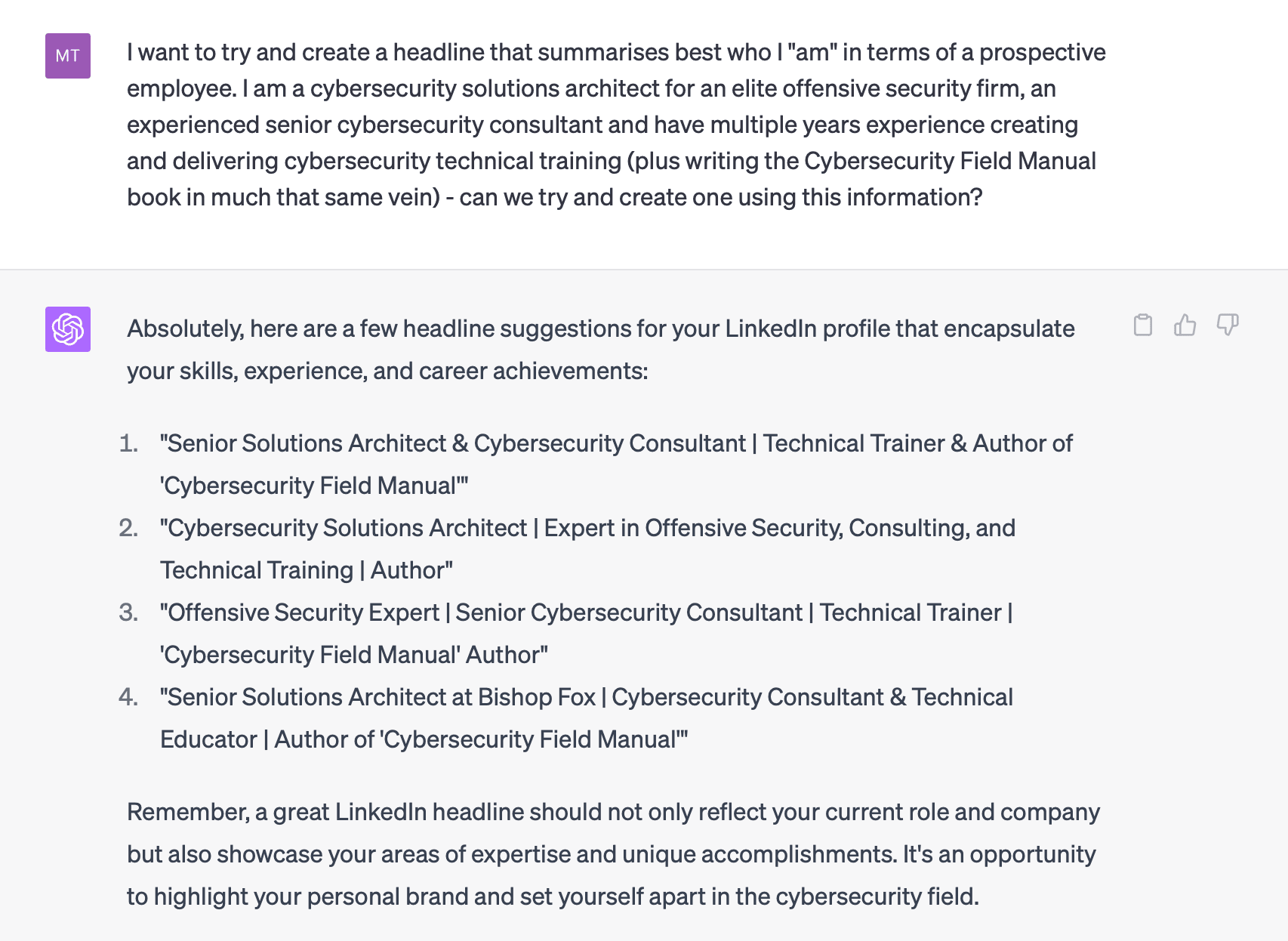
Hey, not bad at all!
- Instinctually, I just don't think this one reads well with the pairing and the way the information is split.
- I like this a lot, but I think it could be sharper - plus it just says "Author" without saying the book's title.
- Same with number 1, I dont think this one reads well with how the information is split, there's too many sections I think.
- This is the best one in my book - I like that the title is accurate for both current job and book title and the information is split into three roughly equal sections.
Okay, so let's take number 4 and rework it some more till it's sharp!
"Senior Solutions Architect at Bishop Fox | Cybersecurity Consultant & Technical Educator | Author of 'Cybersecurity Field Manual'"
I read this through a few times and changed some words around to see how it looked visually and how it read on the screen.
I eventually changed "Senior Solutions Architect at Bishop Fox" to "Senior Cybersecurity Solutions Architect" because it was more specific and changed the section section to "Expert Consultant & Technical Trainer" because I think it sold me better.
Those are my two most practiced skillsets and this is your elevator pitch, after all. Now's the time to sell yourself hard if you're going to!
Now we have:
Senior Cybersecurity Solutions Architect | Expert Consultant & Technical Trainer | Author of Cybersecurity Field Manual
I think this reads well visually on the screen, there aren't too many sections and it effectively sells "me" well in a very short space of time. You can see that I used it on the real thing here.
Profile Content & ActivityThis is mostly a matter of making sure everything in terms of job experience matches your resume and as such, can effectively double as a longer version of it.
There are some little tweaks and additions you can make to sharpen things up though:
- Make sure if you've got certifications and courses from learning platforms that you've finished, put them all on there.
- Won an award from work? Put it on there.
- Published something like a blog or whitepaper? Put it in the relevant section.
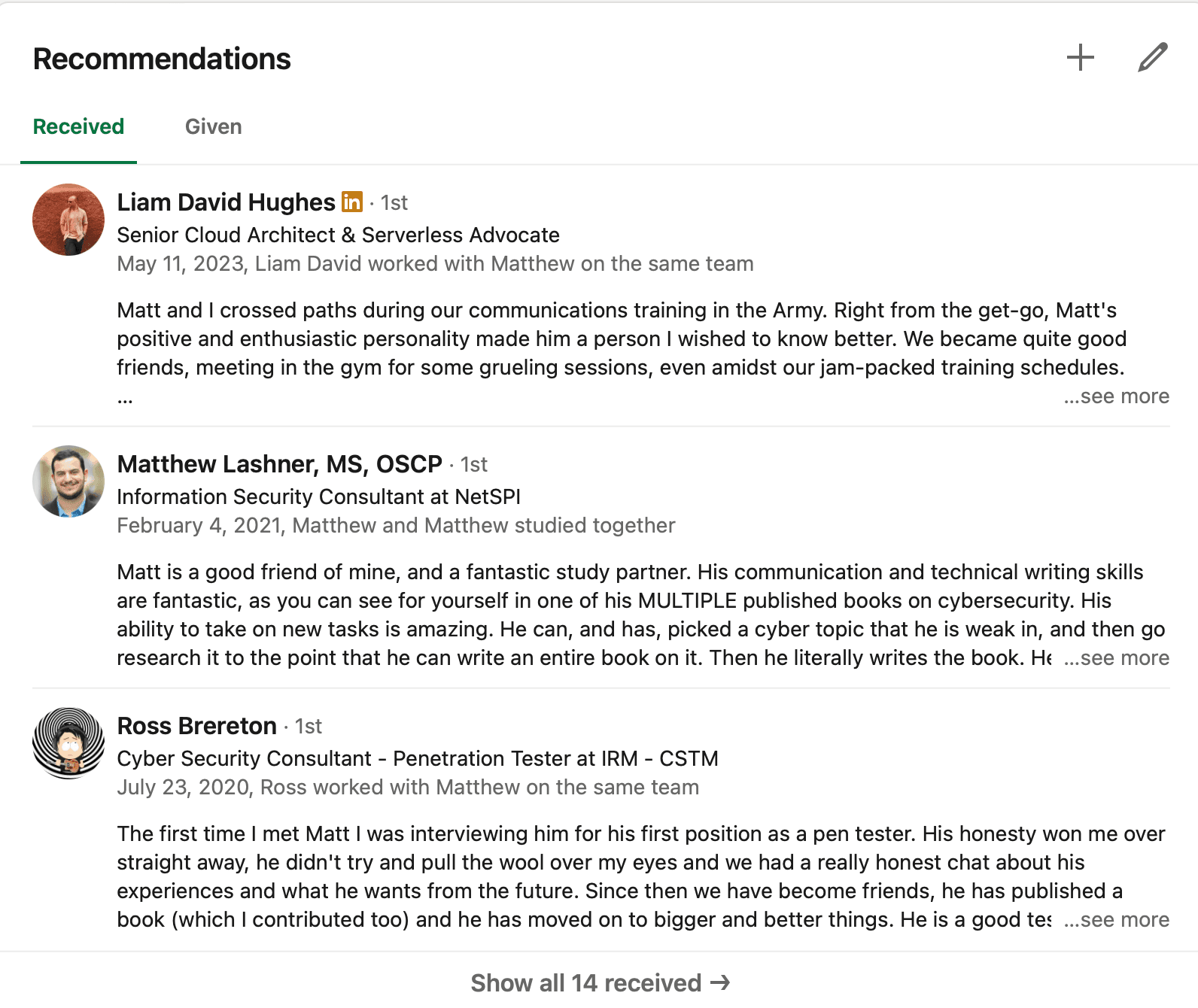
LinkedIn recommendations are in my opinion one of the most underutilized sections of many LinkedIn profiles - and you should try to get as many people in your network as you can to write you an honest one.
First off, they provide social proof/testimonials as to what you're actually like as a person and your work ethic. This helps recruiters make a judgement call on you as a candidate.
LinkedIn's algorithm favors profiles with a higher level of engagement and activity, and recommendations contribute to this engagement and activity.
Recommendations from respected profeessionals can also significantly increase your level of credibility.
LinkedIn Recruiter uses a series of search parameters to help filter down the millions of potential profiles, and this document from them tells you what each filter is looking for when it displays results.
Tweak your profile's content to fit in well with what the search parameters are looking for and you may find you appear in exponentially more searches as a result.
More searches tends to mean more reachouts and DMs in your inbox - which is where job leads come from.
There really isn't much else to say about LinkedIn activity other than "Use LinkedIn for its intended purpose: sharing insightful work-related content and connecting with other professionals".
- Comment on other people's posts in a polite, professional and helpful way.
- LinkedIn isn't Facebook and it's not a dating site, don't be that person.
- Repost content that you find interesting with your own thoughts.
- Post your own thoughts and self-generate content in the form of LinkedIn articles or posts.
This will repeatedly bring your name up in other people's feeds and inevitably a proportion of those people will be recruiters.
Those recruiters might like something you post, click your name and read your profile - at which point all the other work we've done comes in!
Building Fruitful, Long-term Working Relationships With a Recruiter or Headhunter
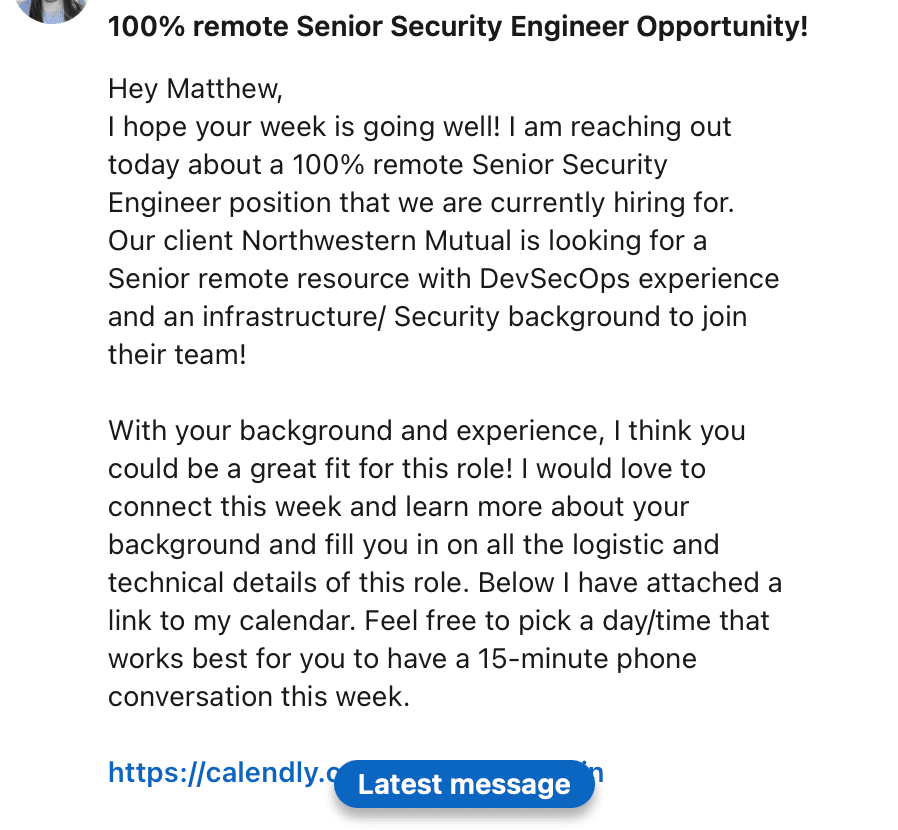
You know you're doing the rest of this stuff right, when messages like these start appearing in your inbox!
This is what we call in sales and recruitment a cold outreach message:
- Cold outreach refers to when the person sending the message has no prior connection to the recipient.
- Warm outreach refers to when you've been referred or namedropped by one of your connections to the sender, and that's why they're messaging you.
- A hot lead refers to when you or the person wanting the product or service (usually the recipient) is in fact the one actively reaching out and sending the meassage.
As cold outreach emails go, this one is actually pretty good:
- Name is spelt correctly, and the greeting is polite.
- Straight to the point, tells me exactly what the recruiter is reaching out about.
- Bonus points in my book for not being coy and just telling me who the client actually is at the other end.
- Job is relevant which means the recruiter did their research and they attached a job specification to the initial DM (saving me asking for it - double points!)
- The call-to-action is for a short call at my choice of time. Considering how upfront they were with a lot of information, this is enough for me to make a judgement call on whether I think it will be worth responding.
I did end up responding and we had a lovely conversation, even though we didn't end up working together in the end.
Advice for Candidates- Recruitment and sales outreach is brutal, brutal work and they're just doing their job - remember there is another human being at the other end of the message.
- Be kind whenever the opportunity allows, there are more than enough assholes propping up the bell curve and you don't need to be another one.
- If you aren't looking for work at the time of the outreach, just be honest and tell them as much but thank them for taking the time to reach out to you. The recruiter will appreciate it, I promise you.
- If the job opportunity in question isn't relevant or in line with what you're looking to do next, refer a friend that is either actively looking for work or that would be relevant.
- This turns cold outreach to you into warm outreach for the next person and you never know who you might be helping out down the line. You will also win major points in the recruiter's book for future roles.
- If the job opportunity isn't relevant, tell the recruiter that but also supply what you are for in your next role. They may have a colleague specialising in that exact line of work!
- Lastly, you're not a Japanese emperor - you're a security consultant, analyst, engineer or penetration tester. This is a hyper-popular market where skilled, experienced labor is at a premium. You're going to have to expect a couple of reachouts every once in a while and they won't all be hyper-targeted to you.
- If you're this kind of person, get your head out of your ass and stop looking for the smallest flaw in the outreach message to blow out of proportion for LinkedIn clout. You aren't helping "clean up the industry", the person is just doing their job and you just look like a dick when you do it.
Treating recruiters with the same respect you'd treat your friends and colleagues will pay huge dividends down the line. The cybersecurity industry is small and every voice speaking your praises in rooms you aren't in will generate helpful tailwinds for you when it's your turn to look for a job.
Advice for Recruiters Reaching Out To Candidates- Candidates get a lot of these outreach messages and all they want to know is how the job you're offering compares to their current one.
- You might not be able to share the entire gamut of information in the initial message (client, salary etc.) but give whatever you can in terms of context, the type of role, projected management duties etc.
- Please don't pretend to be interested in my interests, content or work if you're really not and are just looking for a targeted introduction. I'll sniff you out pretty quickly and it's just disingenuous.
- A polite greeting and getting straight to the point is just fine if you don't actually share XYZ interest of mine.
- "Exciting role with a Fortune 500 client" isn't going to cut it when 40 other recruiters have tried the same thing.
- The candidate isn't going to do the detective work of working out what the role actually is if you don't tell them - it will always be faster to ignore you entirely.
- "Senior resource with X experience and Y background" lets me know if the role is equal to or above my current seniority, whether the background required is something I have and whether the experience required is something I know or can build. This is how you do this effectively.
- Attach any supplemental material you can that helps flesh out the role, context is everything for a candidate that is looking to move or that you're attempting to induce a move for.
- If the candidate does not have the background for your role, is far senior or far junior to the role you're looking for, or is geographically unable to take the role - DO NOT REACH OUT. It is a waste of both yours and the candidate's time.
- I promise you that this type of "numbers game" KPI-matching will get you blocked out of what could be an effective referral or potential reachout down the line - don't do it.
To paraphrase Chris Orlob, sales and recruitment aren't numbers games for top performers, they're impact games. I promise you will see your response rate skyrocket if you do this legwork before reaching out!
The Value of A Recruiter In Your Corner In A Down Market
Anyone who's been working long enough has seen a bear market or two, where people start getting laid off and jobs are harder to come by. In 2023, it's happening as we speak, with over 100,000 laid off already this year.
You might not want to hear it but nobody is bulletproof, not even you - you need to lay the groundwork in case it's you that needs to find a job unexpectedly.
You don't want to be the person unexpectedly let go into a brutally competitive job market where not only are there far more people with your skills in the pool but you also have the fact you were a dick to every recruiter working against you!
Some of the most fruitful and fulfilling professional relationships I have are with recruitment professionals and in almost every bear market I've seen, following the same advice I've typed above resulted in the following happening:
- Advance notice of a slowdown in the market.
- Targeted advice on what sort of offers and packages were being accepted (helping me temper requests and expectations accordingly).
- First opportunity on some fantastic job opportunities as reward for helping them with referrals and job specification shareouts.
- Some extremely timely and useful references and reposts that made the difference between me getting a job and not.
- Invaluable market advice and interview/resume consulting over the years that has given me a significant advantage over the competition.
It's easy to say "I don't need you" to a recruiter or headhunter when the market is great and it's sunny outside, but it never hurts to be nice and useful for when the rain comes back out and you need help getting back into work.
You'll know you've treated people right when it's your turn to stand in the rain and multiple people offer you an umbrella.
Example Outreach Scripts To Use Today
Reaching out yourself to a recruiter can be an effective way to start building out a network before you need one.
But, it's understandably scary if you don't have experience doing outreach yourself, so here are some example outreach messages you can tweak to use in building your own professional network:
- Initial Contact
Hello [Recruiter's Name],
I hope you're having a good week and that you're doing well. My name is [Your Name], and I am a cybersecurity professional with [x] years of experience in the cybersecurity industry focused on [areas of expertise].
I recently came across your profile and was impressed by your extensive experience. As someone who's always looking for opportunities to grow and challenge myself, I am currently seeking new roles that will allow me to utilize my skills effectively.
I thought it would be mutually beneficial if we connected and discussed how we might help each other.
Looking forward to connecting with you.
Best Regards, [Your Name]
- Relating To A Specific Job posting
Dear [Recruiter's Name],
I hope that you're doing well and are having a good day! I recently came across a job posting for the position of [Job Title] that you shared on LinkedIn.
As a professional with [amount of time] in [relevant experience], I am highly interested in applying and truly believe my experience with [specific project] and passion for [specific area relevant to job] makes me an excellent candidate for the role.
I've attached my latest resume and would love the opportunity to discuss this role further, if you so wish.
Thank you for your time and consideration, and I look forward to hearing from you soon.
Best Regards, [Your Name]
- Cold Email to a Headhunter:
Dear [Headhunter's Name],
I hope this message finds you well. I'm [Your Name], a cybersecurity professional with [x] years of experience specializing in [specific skills or fields].
I was drawn to reach out because of your strong reputation in connecting talented professionals with exciting roles at leading companies in the sector.
I'm currently looking to explore new opportunities in cybersecurity, and as such I'm very interested in learning more about how your expertise might help guide my career path. I've attached my resume, which outlines my experience and skills in detail.
If you believe there might be a potential fit for any of the roles you're currently working on, I would be more than happy to discuss further. Even if there's nothing immediately available, I would appreciate any advice you might have for a professional seeking to grow in their career.
Thank you for your time, and I look forward to the possibility of working with you.
Best Regards, [Your Name]
TL;DR / In Conclusion
Recruiter-bashing is just a little passe at this point and is frankly counter-productive when trying to build a professional network and chart a successful career.
You want as many people speaking kindly of you in rooms you're not in, and how you treat everyone, not just those who can help you in an immediate sense says a lot about you.
Build up a network of recruiters and headhunters that you help by sharing content and referring friends and leads to, and it will come back to you later down the line paying major dividends, I promise you.
Things to note:
- Make sure your resume and LinkedIn are working as hard as they possibly can in your favour.
- Utilize every tool at your disposal to stand out - publications, courses and recommendations all help in their own way.
- Leverage tools like ChatGPT or examples you find online to combat "blank page syndrome" if you hate 'selling yourself'.
- If you're a candidate reading this: recruiters and headhunters are doing a difficult job and not everyone is going to nail the outreach every single time.
- Be kind, be respectful and try and help the person out in any way you can - view it as investing in future opportunities.
- If you're a recruiter reading this: candidates are constantly inundated with badly written, low-effort outreach with vague descriptions and roles that on even the smallest inspection are not relevant at all.
- Do your initial discovery work the hard way and it will pay dividends in a higher response rate - Impact game, not a numbers game, remember?
If you enjoyed this article, check out the other articles in the Hacking The Hiring Process series:
- Hacking The Hiring Process: Resumes
- Hacking The Hiring Process: Job Adverts, Specs & Red Flags
- Hacking The Hiring Process: Recruiters & Headhunters
- Hacking The Hiring Process: Initial Phone Screens
- Hacking The Hiring Process: Behavioural/Cultural Fit Interviews & Questioning
- Hacking The Hiring Process: Technical Interviews & Questioning
- Hacking The Hiring Process: Salary Expectations, Offers & Negotiation